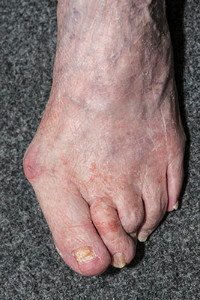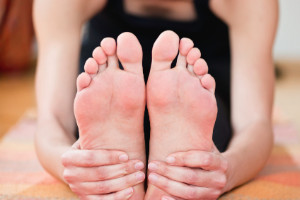
Drexel Hill (484) 521-0233
West Chester (610) 436-5883

Drexel Hill (484) 521-0233
West Chester (610) 436-5883
Toenail fungus, also known as onychomycosis, is a relatively common health condition. Common symptoms of toenail fungus include yellow or brown nails, brittleness, or nails that may lift up from the nail bed. The fungus is contagious and can spread from nail to nail or even infect the foot and cause athlete’s foot. Without treatment, the fungus can worsen, which may be a contributing factor in experiencing pain while wearing shoes. Avoiding toenail fungus is important in maintaining healthy feet. Choosing breathable footwear, wearing proper shoes in public showers, and using foot powders to keep the feet dry can all help in avoiding toenail fungus. Keeping toenails short is also important and aids in preventing ingrown toenails. Additionally, it’s advised that shoes or nail clippers should not be shared, as this may promote spreading of the fungus. If a pedicure is desired, it’s important that the sanitation of pedicure tools occur. For all conditions related to the foot, including toenail fungus, it is important to seek help from a podiatrist.
For more information about treatment, contact the podiatrists of Dr. Siegerman & Associates. Our doctors can provide the care you need to keep you pain-free and on your feet.
Toenail Fungus Treatment
Toenail fungus is a condition that affects many people and can be especially hard to get rid of. Fortunately, there are several methods to go about treating and avoiding it.
Antifungals & Deterrence
Oral antifungal medicine has been shown to be effective in many cases. It is important to consult with a podiatrist to determine the proper regiment for you, or potentially explore other options.
Applying foot powder on the feet and shoes helps keep the feet free of moisture and sweat.
Sandals or open toed shoes – Wearing these will allow air movement and help keep feet dry. They also expose your feet to light, which fungus cannot tolerate. Socks with moisture wicking material also help as well.
If you have any questions please feel free to contact one of our offices located in Drexel Hill and West Chester, PA . We offer the newest diagnostic tools and technology to treat your foot and ankle needs.
 While the exact cause of bunions is unknown, there are things that can exacerbate them. These may include improper footwear, such as pointed shoes, high heels, and shoes that are too narrow across the bottom of the toes. Since the toe typically bears most of the body’s weight, poor footwear can lead to increased wear and tear; this can increase the severity of bunions. Additionally, genetics may play a role because foot structure and shape are hereditary. It’s also common for bunions to become more pronounced for those whose occupations consist of standing or walking. Treatments can include adding padding in the shoes for protection, wearing a shoe with a flexible sole for support, and possibly stretching your shoes to make room for the bunion. If you think you have a bunion, it is recommended to consult a podiatrist for a proper evaluation.
While the exact cause of bunions is unknown, there are things that can exacerbate them. These may include improper footwear, such as pointed shoes, high heels, and shoes that are too narrow across the bottom of the toes. Since the toe typically bears most of the body’s weight, poor footwear can lead to increased wear and tear; this can increase the severity of bunions. Additionally, genetics may play a role because foot structure and shape are hereditary. It’s also common for bunions to become more pronounced for those whose occupations consist of standing or walking. Treatments can include adding padding in the shoes for protection, wearing a shoe with a flexible sole for support, and possibly stretching your shoes to make room for the bunion. If you think you have a bunion, it is recommended to consult a podiatrist for a proper evaluation.
If you are suffering from bunions, contact the podiatrists of Dr. Siegerman & Associates. Our doctors can provide the care you need to keep you pain-free and on your feet.
What Is a Bunion?
A bunion is formed of swollen tissue or an enlargement of boney growth, usually located at the base joint of the toe that connects to the foot. The swelling occurs due to the bones in the big toe shifting inward, which impacts the other toes of the foot. This causes the area around the base of the big toe to become inflamed and painful.
Why Do Bunions Form?
Genetics – Susceptibility to bunions are often hereditary
Stress on the feet – Poorly fitted and uncomfortable footwear that places stress on feet, such as heels, can worsen existing bunions
How Are Bunions Diagnosed?
Doctors often perform two tests – blood tests and x-rays – when trying to diagnose bunions, especially in the early stages of development. Blood tests help determine if the foot pain is being caused by something else, such as arthritis, while x-rays provide a clear picture of your bone structure to your doctor.
How Are Bunions Treated?
If you have any questions, please feel free to contact one of our offices located in Drexel Hill and West Chester, PA . We offer the newest diagnostic and treatment technologies for all your foot care needs.
The human foot consists of many bones, tendons, ligaments, and muscles. Because it’s the most weight-bearing part of the body, it’s common to experience foot pain at some point in your life. Common conditions can include tight cramping muscles, bunions, and hammertoes. Performing foot exercises to strengthen the muscles may reduce discomfort in the feet. Typically, toe lifts and toe curls are some of the most effective stretches performed to strengthen the foot. Additionally, calf raises and pointing, and stretching the ankle may also work well in helping to build muscle. An Achilles stretch is beneficial in stretching the muscles of the calf, which may help with plantar fasciitis. Stretching the feet not only feels good, it’s necessary in maintaining proper foot health. Be sure to consult a podiatrist to learn if stretching is right for you.
Foot therapy is often necessary for those recovering from either foot deformities or foot injuries. If you have concerns regarding therapy, consult with the podiatrists from Dr. Siegerman & Associates. Our doctors can provide the care you need to keep you pain-free and on your feet.
Most Common Injuries
People who are active or athletes are prone to a variety of injuries. Therefore, it is often important to take part in physical therapy in order to quickly get back on the right track.
What to Do When Injured
Physical Therapy – This specialized treatment will focus on the affected area, speeding up recovery and the overall healing process. It is a proven method that has helped millions of people return from any injury.
During physical therapy you will undergo regimented training to get back into full form. Training is often very difficult, especially at first when the foot feels weak. Physical therapy often involves:
Basic stretching and twisting exercises – getting the feet’s mobility and flexibility up.
Massaging – the therapist will massage the injured area in order to activate the muscles and relax them.
Strengthening Exercises – this allows the muscles in the affected area to regain their full strength, a vital step towards full recovery.
If you have any questions please feel free to contact one of our offices located in Drexel Hill and West Chester, PA . We offer the newest diagnostic tools and technology to treat your foot and ankle needs.
 There is a close relationship between the muscles in the legs and those in the feet. If there is pain in the leg muscles, it can make it difficult for the muscles in the foot to do their job. It is beneficial to stretch the foot muscles to keep your feet fit and healthy. An effective stretch is called “the tendon stretch”, where the heels extend beyond the edge of a step. Another common stretch is called “the knee hug”, where you cross one knee over the other, and "hug" that knee toward your chest. These are a few of the many stretching techniques for your feet and legs. If you feel pain in your feet while stretching, it is recommended that you stop immediately and see a podiatrist for treatment.
There is a close relationship between the muscles in the legs and those in the feet. If there is pain in the leg muscles, it can make it difficult for the muscles in the foot to do their job. It is beneficial to stretch the foot muscles to keep your feet fit and healthy. An effective stretch is called “the tendon stretch”, where the heels extend beyond the edge of a step. Another common stretch is called “the knee hug”, where you cross one knee over the other, and "hug" that knee toward your chest. These are a few of the many stretching techniques for your feet and legs. If you feel pain in your feet while stretching, it is recommended that you stop immediately and see a podiatrist for treatment.
Stretching the feet is a great way to prevent injuries. If you have any concerns with your feet consult with the podiatrists from Dr. Siegerman & Associates. Our doctors will assess your condition and provide you with quality foot and ankle treatment.
Stretching the Feet
Being the backbone of the body, the feet carry your entire weight and can easily become overexerted, causing cramps and pain. As with any body part, stretching your feet can serve many benefits. From increasing flexibility to even providing some pain relief, be sure to give your feet a stretch from time to time. This is especially important for athletes or anyone performing aerobic exercises, but anyone experiencing foot pain or is on their feet constantly should also engage in this practice.
Great ways to stretch your feet:
Individuals who tend to their feet by regular stretching every day should be able to minimize foot pain and prevent new problems from arising.
If you have any questions, please feel free to contact one of our offices located in Drexel Hill and West Chester, PA . We offer the newest diagnostic and treatment technologies for all your foot care needs.
Request a free copy of
Laser Away Foot Pain!
today.
